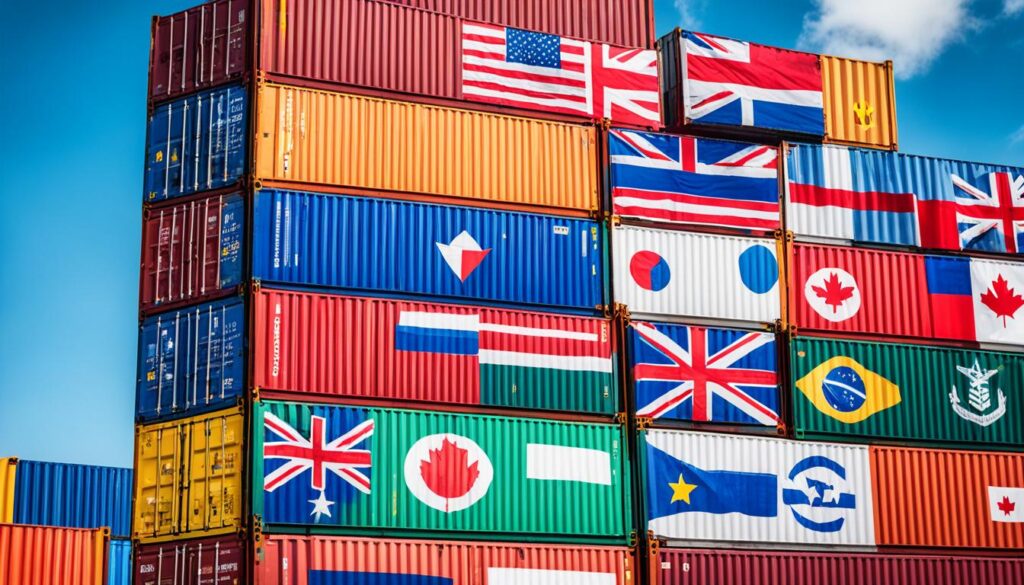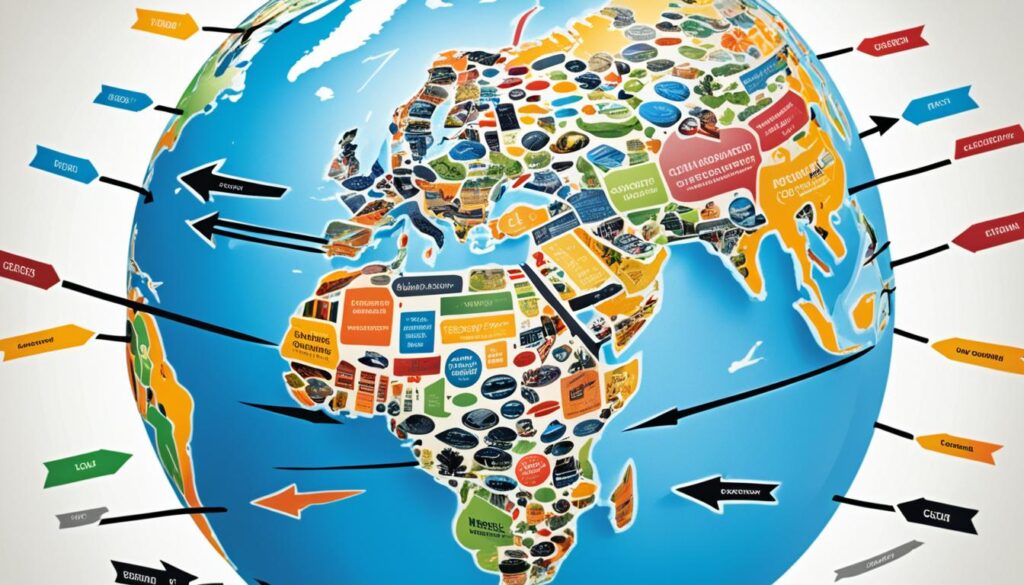Are you ready to take your business to the global stage? Expanding into new markets through exporting can be a game-changer for your business. But what does it really take to succeed in this endeavor? From navigating complex export compliance regulations to developing a robust export strategy, there are essential factors that can make or break your global market expansion.
In this comprehensive guide, I will walk you through everything you need to know about exporting. We will explore market research methods to identify the most promising opportunities, delve into the intricacies of export planning and creating a roadmap for success, and discuss various route to market options that can help you choose the right approach for your business. We will also cover important topics such as trade fairs, marketing tactics, administrative requirements, payment and insurance, legal considerations, and transport logistics.
Whether you are a seasoned exporter or just getting started, this article will provide you with practical insights and expert advice to enhance your exporting endeavors. Get ready to unlock the global potential of your business!
Key Takeaways:
- Thorough market research is crucial for identifying opportunities and understanding the target market
- Creating a comprehensive export plan helps in mapping out the necessary steps and resources
- Choosing the right route to market can significantly impact your success in exporting
- Trade fairs provide excellent opportunities for networking and finding potential buyers
- Effective marketing tactics and proper administrative compliance are essential for successful exporting
Market Research: Identifying Opportunities
Before embarking on an exporting journey, thorough market research is crucial. This involves conducting an export market analysis to identify potential markets and opportunities for expansion. By examining consumption figures, import data, and economic growth rates, businesses can gain valuable insights into the market potential for their products.
Market research goes beyond just numbers and statistics. It is also important to consider the demographics and cultural practices of the target market, as well as the competition landscape. Understanding the needs and preferences of the target audience and analyzing the strategies and offerings of existing competitors will help businesses develop a comprehensive export strategy.
One effective approach to market research is to utilize new market research techniques, such as surveys, focus groups, and interviews, to gather valuable customer insights. These research methods can provide businesses with a deeper understanding of consumer behavior, preferences, and market trends, allowing them to tailor their export strategy accordingly.
Benefits of Market Research for Exporting
- Identify potential markets and target audience
- Evaluate market potential and demand for products
- Understand cultural practices and preferences
- Analyze competition and differentiate products
- Develop a strategic export plan
Market Research Checklist
| Research Aspect | Description |
|---|---|
| Consumption Figures | Analyze data on consumer spending and consumption patterns within the target market. |
| Import Data | Study import statistics to identify potential demand for specific products or services. |
| Economic Growth Rates | Assess the economic growth and stability of the target market for long-term export opportunities. |
| Demographics | Consider population size, age distribution, income levels, and other demographic factors to understand the target audience. |
| Cultural Practices | Research and adapt to the cultural practices, customs, and preferences of the target market. |
| Competition Analysis | Study existing competitors, their offerings, pricing strategies, and market positioning. |

Export Planning: Creating a Roadmap
Developing a comprehensive export plan is essential for success. As I embark on the journey of exporting, I understand the importance of careful planning to ensure a smooth and profitable experience. In this section, I will outline the key considerations that should be included in an export plan: the required export team, capacity assessment, packaging requirements, and acquiring knowledge about the potential new market through trade fairs and networking.
Required Export Team
An export venture requires a skilled and dedicated team to navigate the complexities of international trade. When creating an export plan, I will assess the resources needed to support exporting activities effectively. This includes identifying individuals or departments responsible for managing logistics, documentation, compliance, and sales in the target market. By establishing a capable export team, I can ensure that all aspects of the exporting process are handled efficiently.
Assessing Capacity to Meet Market Demands
Before expanding into new markets, it is crucial to assess whether my business has the capacity to meet the demands of these markets. In the export plan, I will evaluate factors such as production capabilities, inventory levels, and supply chain management. This assessment will help me determine if any adjustments or investments are necessary to increase capacity and ensure smooth operations.
Packaging Requirements for Target Markets
Each market may have specific packaging requirements that must be taken into account. To successfully penetrate new markets, I must consider packaging design adjustments to align with local preferences, regulations, and cultural norms. This may include adapting labeling, instructions, and product presentation. By customizing packaging for target markets, I can enhance the appeal of my products and meet regulatory standards.
Acquiring Knowledge Through Trade Fairs and Networking
Trade fairs and networking events provide valuable opportunities to gain insights into potential new markets. Attending relevant trade fairs allows me to connect with industry experts, explore market trends, and gather market intelligence. Networking with professionals and potential business partners can provide valuable guidance and support for my export journey. By actively participating in trade fairs and networking, I can learn from experienced professionals and establish vital contacts for future business collaborations.
Creating a detailed export plan is essential to guide my company’s journey into new markets. By considering the required export team, assessing capacity to meet market demands, understanding packaging requirements, and acquiring knowledge through trade fairs and networking, I am confident in my ability to navigate the complexities of exporting and achieve success in the global market.

Route to Market Options: Choosing the Right Approach
Choosing the right route to market is crucial for the success of your exporting endeavors. It involves evaluating different options and selecting the approach that aligns with your business goals and target markets. There are four main options to consider: direct selling, distribution, sales agents, and joint ventures.
1. Direct Selling:
Direct selling refers to selling your products directly to customers in the target market, bypassing intermediaries. This option gives you full control over your sales and customer relationships. It allows you to establish a strong brand presence and gain valuable insights into customer preferences. However, it also requires significant investment in marketing, customer support, and distribution logistics.
2. Distribution:
Distribution involves partnering with local distributors in the target market who will handle the sales and distribution of your products. This option allows you to leverage the distributor’s existing network and market knowledge, enabling you to reach a wider customer base. However, it requires careful selection of reliable and competent distributors, as well as effective communication and coordination to ensure product availability and brand consistency.
3. Sales Agents:
Sales agents act as intermediaries between your company and potential customers. They promote and sell your products, earning a commission for each successful sale. Sales agents typically have extensive knowledge of the local market and established networks, making them valuable partners for market entry. However, effective management and regular communication are essential to ensure sales agents represent your brand in alignment with your company’s values and objectives.
4. Joint Ventures:
Joint ventures involve partnering with a local company in the target market to develop and market products together. This option allows you to combine resources, knowledge, and market insights, reducing risks and increasing market penetration. Joint ventures can provide access to distribution networks, local expertise, and shared costs. However, it requires careful evaluation of the potential partner’s compatibility, shared vision, and intellectual property protection.
When considering the route to market, it is crucial to prioritize intellectual property protection throughout the export process. Safeguarding your brand, patents, trademarks, and trade secrets is essential to prevent unauthorized use or infringement. Consult with legal experts to establish appropriate contracts and agreements that protect your intellectual property rights in the target market.

By carefully evaluating these options and selecting the one that suits your business objectives and target market, you can enhance your export strategy and increase your chances of success.
Trade Fairs: Finding Opportunities
Trade fairs are a valuable avenue for exporters to connect with potential buyers and expand their business internationally. Whether it’s a domestic or international trade fair, these events provide an ideal platform for showcasing products, networking with industry professionals, and exploring new market prospects.
Attending trade fairs allows exporters to gather valuable market insights, establish strong business relationships, and generate leads for potential sales. It’s an opportunity to present your products or services directly to a targeted audience, enhancing brand visibility and attracting potential buyers from various markets.
When participating in trade fairs, it’s vital to make the most of the experience and stand out from the competition. Here are some strategies to optimize your trade fair presence:
- Research the trade fair: Prioritize trade fairs that are relevant to your industry and target market. Identify exhibitions with a track record of attracting your desired audience.
- Apply for grants: Explore available grants and subsidies that can help offset the cost of exhibiting at trade fairs. This can make participation more affordable and accessible for exporters.
- Collaborate with other businesses: Consider sharing a stand with complementary businesses to reduce costs and increase visibility. This allows for cross-promotion and the opportunity to tap into a wider customer base.
- Prepare an impressive booth: Design an eye-catching booth that reflects your brand identity and showcases your products effectively. Use signage, banners, and promotional materials to attract visitors and communicate your unique selling points.
- Engage in active networking: Actively engage with trade fair attendees and other exhibitors. Network with industry professionals, potential buyers, and suppliers to expand your business connections and explore partnership opportunities.
Attending trade fairs offers more than just immediate sales opportunities. It allows you to gain market intelligence, explore new market segments, and establish valuable contacts within the industry. Don’t miss out on the chance to leverage these platforms for business growth and international expansion.
“Attending trade fairs allows exporters to gather valuable market insights, establish strong business relationships, and generate leads for potential sales.”
Trade Fair Success Story: XYZ Company
XYZ Company, a leading manufacturer of eco-friendly cleaning products, participated in the Green Solutions Trade Fair in New York City. The event brought together sustainability-focused companies and environmentally conscious consumers. XYZ Company seized the opportunity to showcase its innovative cleaning solutions and connect with potential buyers and distributors.
Their booth featured interactive product demonstrations and informative displays highlighting the benefits of their eco-friendly cleaning products. The team actively engaged with attendees, offering personalized product recommendations and sharing success stories from satisfied customers.
As a result of their participation in the trade fair, XYZ Company established new distribution partnerships and secured contracts with major retailers. The exposure gained from the event also led to media coverage and increased brand recognition within the industry.
Trade fairs like the Green Solutions Trade Fair played a pivotal role in XYZ Company’s success, enabling them to expand their market reach, forge valuable business connections, and position themselves as leaders in the sustainable cleaning industry.

Marketing Tactics: Promoting Your Products
Effective marketing tactics play a crucial role in the success of your exporting ventures. While traditional advertising methods like print ads can be costly, it is important to assess your target audience and evaluate the return on investment. To promote your products in a cost-effective and efficient manner, consider the following strategies:
Create a Localized Website

One of the most important steps in promoting your products for export is to create a localized website. This means tailoring your website content to the language, culture, and preferences of your target market. By addressing the specific needs and interests of local customers, you can enhance their trust and confidence in your brand.
Utilize Global Social Media Platforms
Social media marketing is a powerful tool for promoting your products to a global audience. Platforms like LinkedIn, Facebook, and Twitter offer cost-effective ways to increase brand visibility, engage with potential customers, and generate leads. Develop a social media strategy that aligns with your target market, creating relevant and engaging content to grab their attention.
Ensure Updated Contact Details
When promoting your products for export, it is crucial to provide up-to-date contact details. This includes your company’s address, phone number, email, and website. Make it easy for potential customers to reach you and inquire about your products or services. Additionally, designate a responsible person for export sales and provide their contact information to facilitate smooth communication.
“Effective marketing tactics are the cornerstone of successful exporting. By localizing your website, utilizing social media platforms, and ensuring updated contact details, you can effectively promote your products to global markets.” – John Smith, Marketing Expert
Administrative Requirements: Ensuring Compliance
Exporting goods to international markets involves various administrative obligations and legal considerations that businesses must address to ensure compliance and avoid potential issues. From customs registration and export documentation to navigating EU regulations and international legal considerations, understanding and fulfilling these requirements is crucial to a successful export operation.
Customs Registration
Customs registration is a necessary step in the exporting process as it enables businesses to declare and clear goods through customs authorities. Each country has its own customs requirements, procedures, and documentation. It is essential to research and comply with the customs registration process of the target country to avoid delays or penalties.
Export Documentation
Export documentation plays a vital role in international trade and serves as evidence of the export transaction. Properly completed and accurate documentation ensures smooth customs clearance and compliance with export regulations. Some common export documents include commercial invoices, packing lists, bill of lading, export licenses, and certificates of origin.
| Common Export Documents | Description |
|---|---|
| Commercial Invoice | A document that provides details of the goods being exported, including their value, quantity, and terms of sale. |
| Packing List | An itemized list describing the contents of each shipment, including the quantity, weight, and dimensions of the goods. |
| Bill of Lading | A document issued by the carrier that acknowledges receipt of the goods for shipment and serves as a contract of carriage. |
| Export License | A government-issued document granting permission to export certain goods to specific destinations, if required. |
| Certificate of Origin | A document that certifies the country of origin of the goods and is often required for customs clearance. |
EU Regulations
When exporting to or from European Union (EU) countries, businesses must comply with EU regulations. These regulations cover a wide range of matters, such as product standards, safety requirements, labeling, and packaging. Additionally, VAT registration numbers are mandatory to include on invoices for EU exports. Businesses should thoroughly research and understand these regulations to ensure compliance.
International Legal Considerations
Exporting goods involves navigating international legal considerations specific to each target market. This includes understanding and complying with local laws, regulations, and standards related to product labeling, certifications, customs procedures, intellectual property rights, and more. Seeking support from local experts and consulting with international lawyers can provide valuable guidance in understanding these legal complexities.
Complying with administrative requirements and legal regulations is crucial for a smooth export process. Failure to comply may result in delays, fines, or even the inability to export goods altogether. By understanding and fulfilling customs registration, export documentation, EU regulations, and international legal considerations, businesses can navigate the complexities of international trade with confidence, while ensuring compliance and successful global expansion.
Payment and Insurance: Securing Your Finances
When it comes to exporting, ensuring timely payments and securing your finances is vital for the success of your business. By familiarizing yourself with Incoterms, internationally agreed-upon rules for goods trade, you can clarify the responsibilities for transportation, insurance, taxes, and pick-up points. This will help prevent any misunderstandings or disputes that may arise during the export process.
Proper export documentation is also essential to protect your interests and ensure contractual agreements are upheld. By providing written quotations that include detailed product information, price, and delivery terms, you establish clear expectations with your customers. This transparency not only helps you avoid potential disputes but also promotes trust and demonstrates professionalism.
“It is crucial to offer written quotations with detailed product information, price, and delivery terms to avoid disputes and maintain transparency with customers.”
When it comes to payment methods in exporting, there are various options to consider. Secure payment methods like cash-in-advance or letters of credit can provide you with the assurance that you will be compensated for your goods. These methods protect you against non-payment or delays in payment, reducing the financial risks associated with exporting.
Additionally, it is important to have insurance coverage to protect your goods during transportation. Accidents, theft, or damage can occur during transit, and having insurance coverage ensures that you are financially protected in such situations.
Benefits of Securing Your Finances:
- Minimize financial risks associated with exporting.
- Establish clear expectations with customers through written quotations.
- Choose secure payment methods to ensure timely compensation.
- Protect your goods with insurance coverage.
Securing your finances through proper payment methods and insurance coverage is crucial for a successful exporting endeavor. By taking these steps, you can minimize financial risks and establish a solid foundation for your business.
| Securing Your Finances in Exporting | Key Considerations |
|---|---|
| Incoterms | Clarify responsibilities for transportation, insurance, taxes, and pick-up points. |
| Export Documentation | Ensure contractual agreements and avoid potential disputes. |
| Written Quotations | Establish clear expectations and promote transparency with customers. |
| Payment Methods | Choose secure options like cash-in-advance or letters of credit. |
| Insurance Coverage | Protect your goods during transportation. |
Image:
Legal Considerations: Protecting Your Interests
When engaging in global exporting, it is essential to understand and comply with legal regulations to ensure a smooth and successful journey. Protecting your interests involves various aspects, including obtaining compliance certificates, safeguarding intellectual property rights, and registering trademarks.
Compliance Certificates
Compliance certificates are crucial documents that validate the adherence of your products to regulatory standards and specifications. These certificates ensure that your products meet the necessary safety, quality, and environmental requirements in each target market. Obtaining compliance certificates demonstrates your commitment to transparency and consumer protection.
Intellectual Property Rights
Intellectual property rights (IPR) encompass patents, trademarks, copyrights, and trade secrets. It is important to protect your IPR to prevent unauthorized use, replication, or counterfeiting of your products or brand. Registering your trademarks in each target market grants you legal protection and exclusivity, preventing others from using similar marks that can cause confusion among consumers.
Benefits of Protecting Intellectual Property Rights
| Benefits | Description |
|---|---|
| Legal Protection | Provides a legal basis to enforce your rights and seek damages if infringement occurs. |
| Brand Recognition | Builds a strong brand identity and distinguishes your products from competitors. |
| Increased Market Value | Enhances the attractiveness of your business to potential investors, partners, and buyers. |
| Long-Term Business Growth | Establishes a foundation for sustained growth and expansion into new markets. |
Seeking Legal Advice
International trade laws can be complex, and seeking legal advice is essential to ensure compliance and mitigate risks. Consulting with local experts and international lawyers who specialize in export regulations can provide valuable guidance and support. They can help you navigate the legal landscape of each target market, protect your interests, and minimize potential challenges or disputes.
Transport Logistics: Ensuring Smooth Delivery
Once the sale is made, efficient transport logistics are essential for successful exporting. It is crucial to consider various factors, including freight forwarding, customs clearance, packaging requirements, and shipping methods. By focusing on these key areas, exporters can ensure smooth and timely delivery of their goods.
Freight Forwarding
One of the most critical aspects of transport logistics is freight forwarding. Freight forwarders play a key role in coordinating and managing the movement of goods from the exporter to the importer. They handle the complexities of international shipping, including documentation, customs requirements, and finding the most cost-effective and efficient shipping routes. By leveraging the expertise of a reliable freight forwarder, exporters can streamline their shipping process and reduce the risk of shipment delays or errors.
Customs Clearance
Customs clearance is another crucial aspect of transport logistics. Each country has its own customs regulations and procedures that must be followed when importing goods. Failure to comply with these requirements can result in costly delays or even confiscation of the goods. It is essential for exporters to work closely with their freight forwarders or customs brokers to ensure all necessary documentation, such as commercial invoices, packing lists, and certificates of origin, is prepared accurately and submitted on time. This will help expedite the customs clearance process and ensure the smooth flow of goods.
Packaging Requirements
Proper packaging is key to protecting goods during transportation and ensuring their safe arrival at the destination. Different markets may have specific packaging requirements that must be adhered to. These requirements may include regulations on labeling, product information, and packaging materials. It is important for exporters to understand and comply with these packaging requirements to avoid any issues or rejections at customs. Partnering with packaging experts and understanding market-specific packaging standards will help exporters meet these requirements effectively.
Shipping Methods
Choosing the right shipping method is crucial when it comes to transport logistics. Different products and markets may require specific shipping methods to ensure cost-efficient and timely delivery. Common shipping methods include sea freight, air freight, and road transport. Sea freight is often preferred for bulky or heavy cargo, while air freight is faster but more costly. Road transport is suitable for shorter distances or when flexibility is required. By carefully considering product specifications, delivery timelines, and budget constraints, exporters can select the most appropriate shipping method for each export order.
Tips for Success: Building a Strong Exporting Brand
Building a successful exporting brand requires a strategic approach that considers customer communication, on-time delivery, continuous promotion, and expanding into new markets. To start, maintaining regular communication with customers is key. By staying in touch, you can gather valuable feedback, address concerns promptly, and identify areas for improvement in your products and services.
Delivering orders on time is crucial for customer satisfaction. However, delays may occur due to unforeseen circumstances. In such cases, it is important to manage any delays proactively by providing transparent updates and alternative solutions. Effective communication throughout the delivery process can help maintain trust and loyalty with your customers.
Continuous promotion is essential for building a strong exporting brand. Participating in trade shows, both domestically and internationally, provides valuable opportunities to showcase your products, network with potential buyers, and increase brand visibility. Actively engaging in marketing activities, such as advertising and utilizing social media platforms, can also help promote your products and expand your customer base.
Once you have established a successful presence in one market, consider expanding into new markets. Look for adjacent countries or those with similar characteristics that may present untapped opportunities for your products. Conducting thorough market research in these potential markets will help you understand the demand, competition, and cultural nuances before entering.






